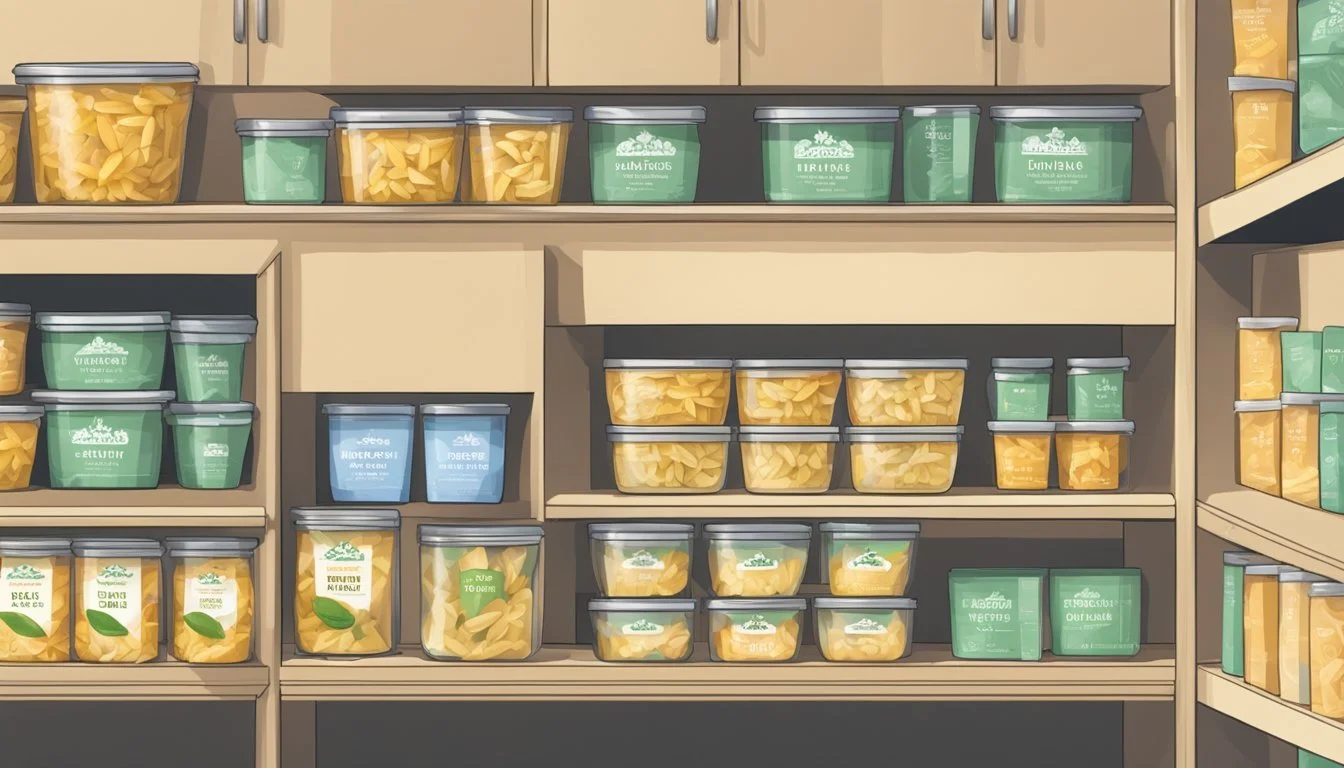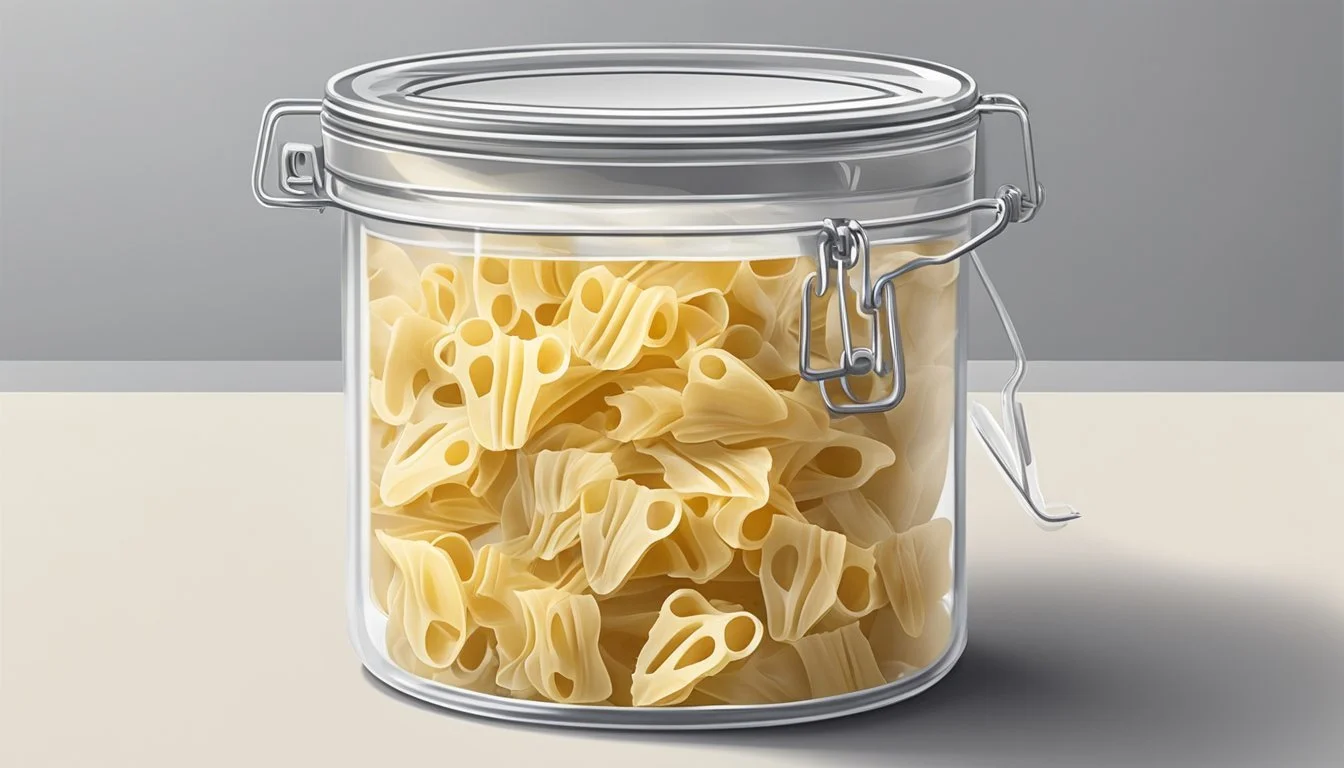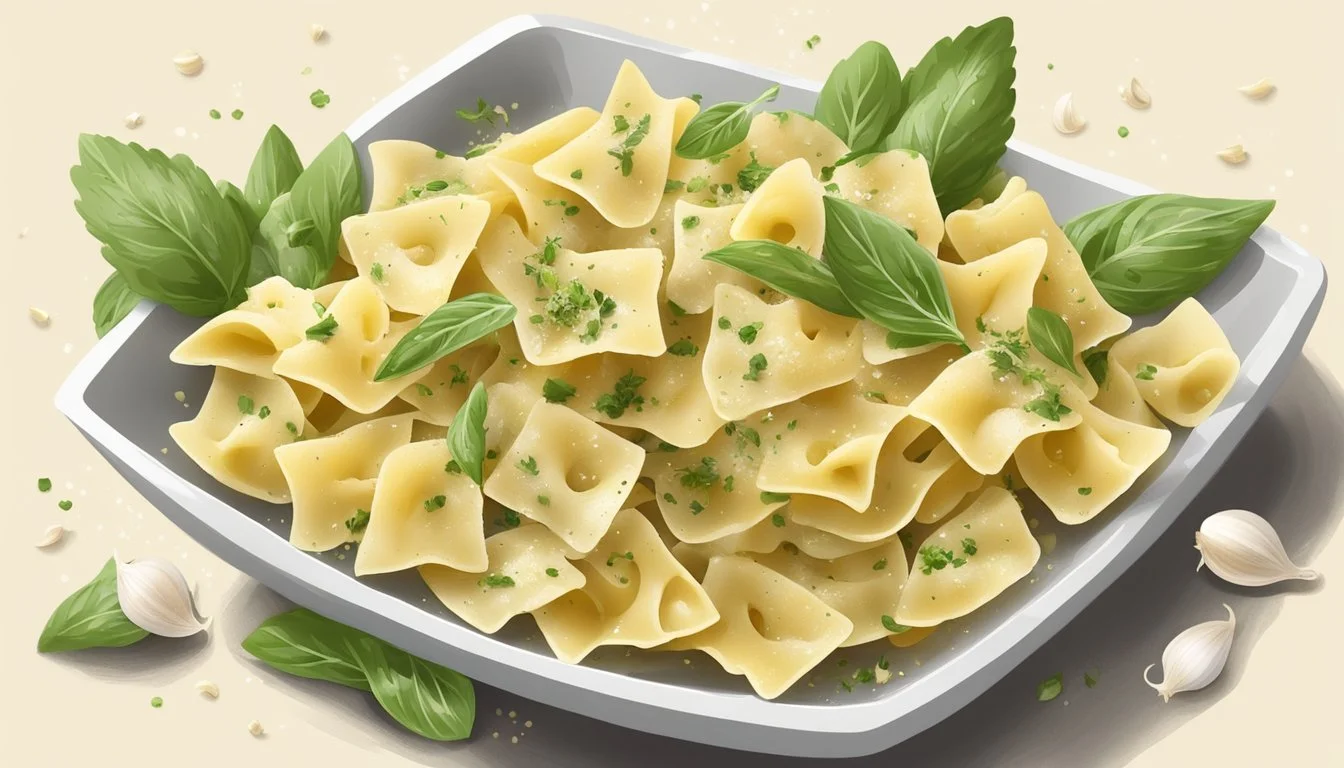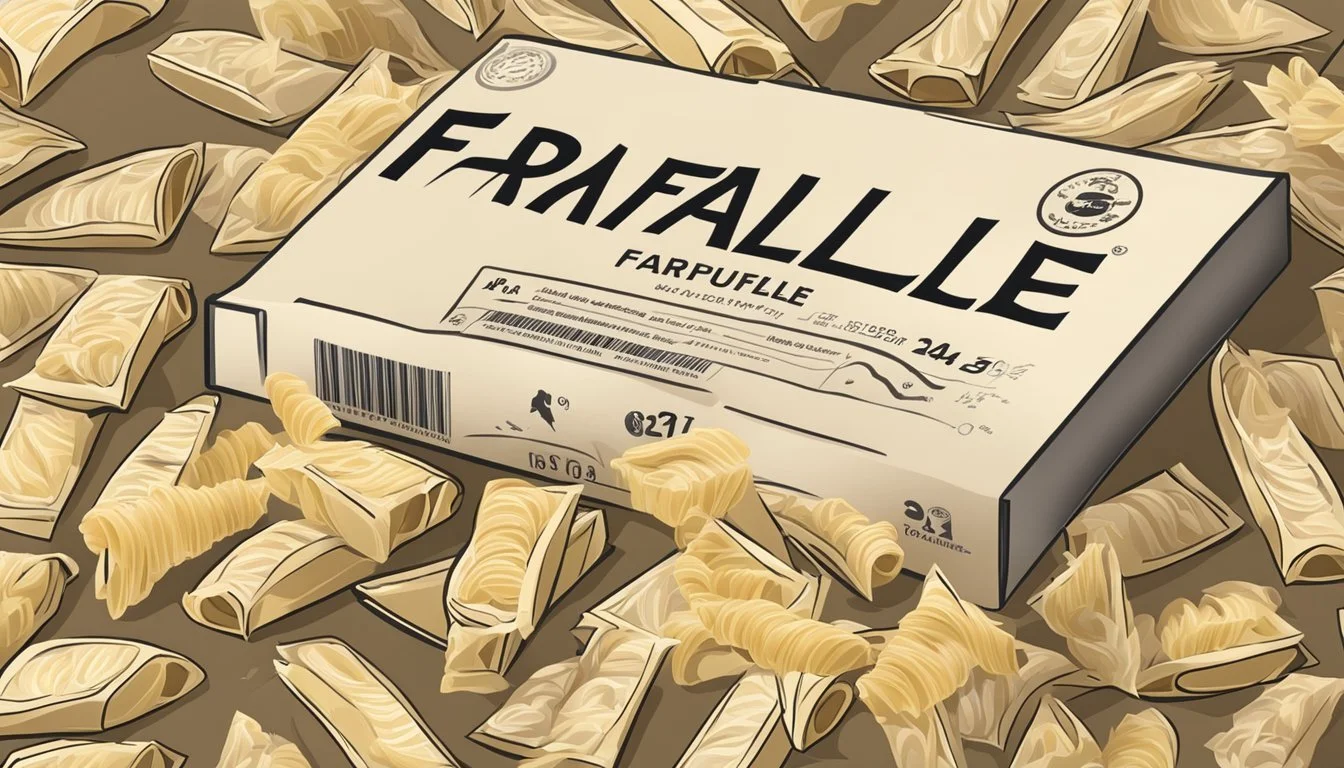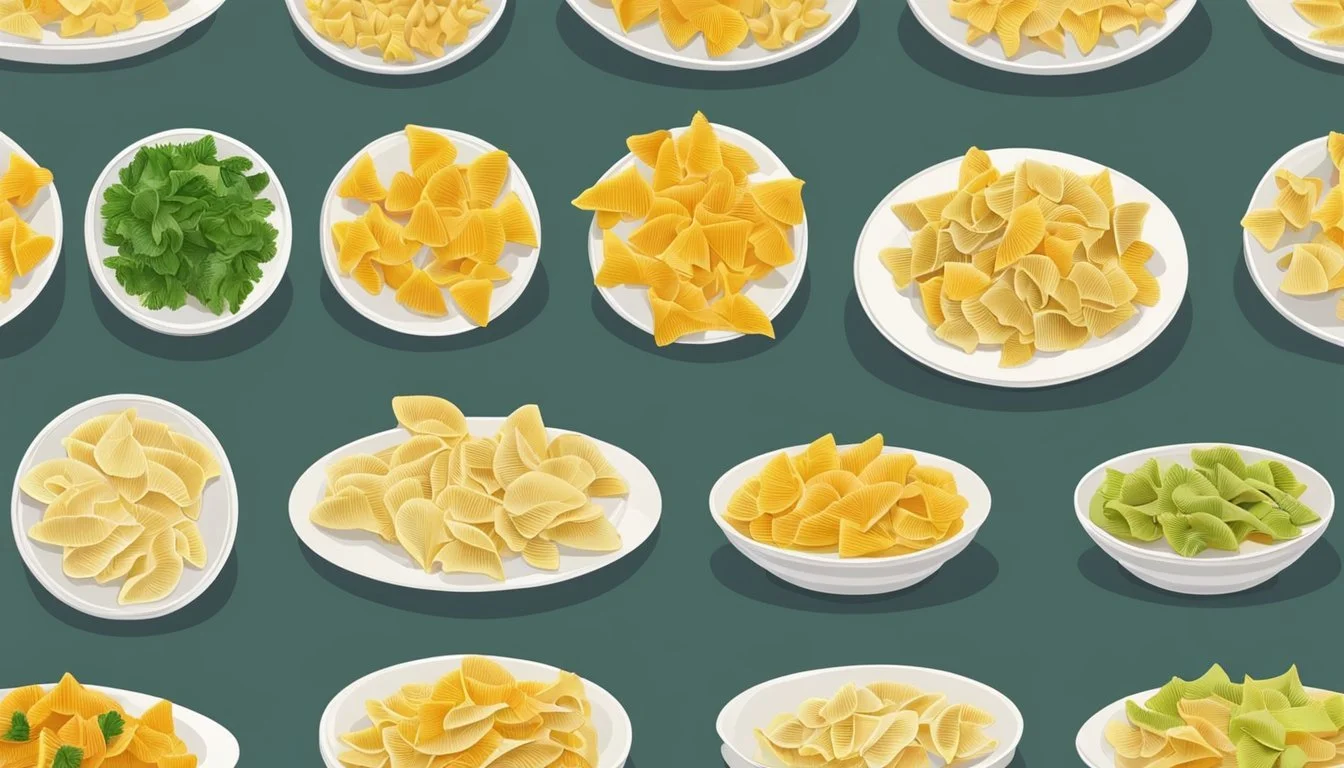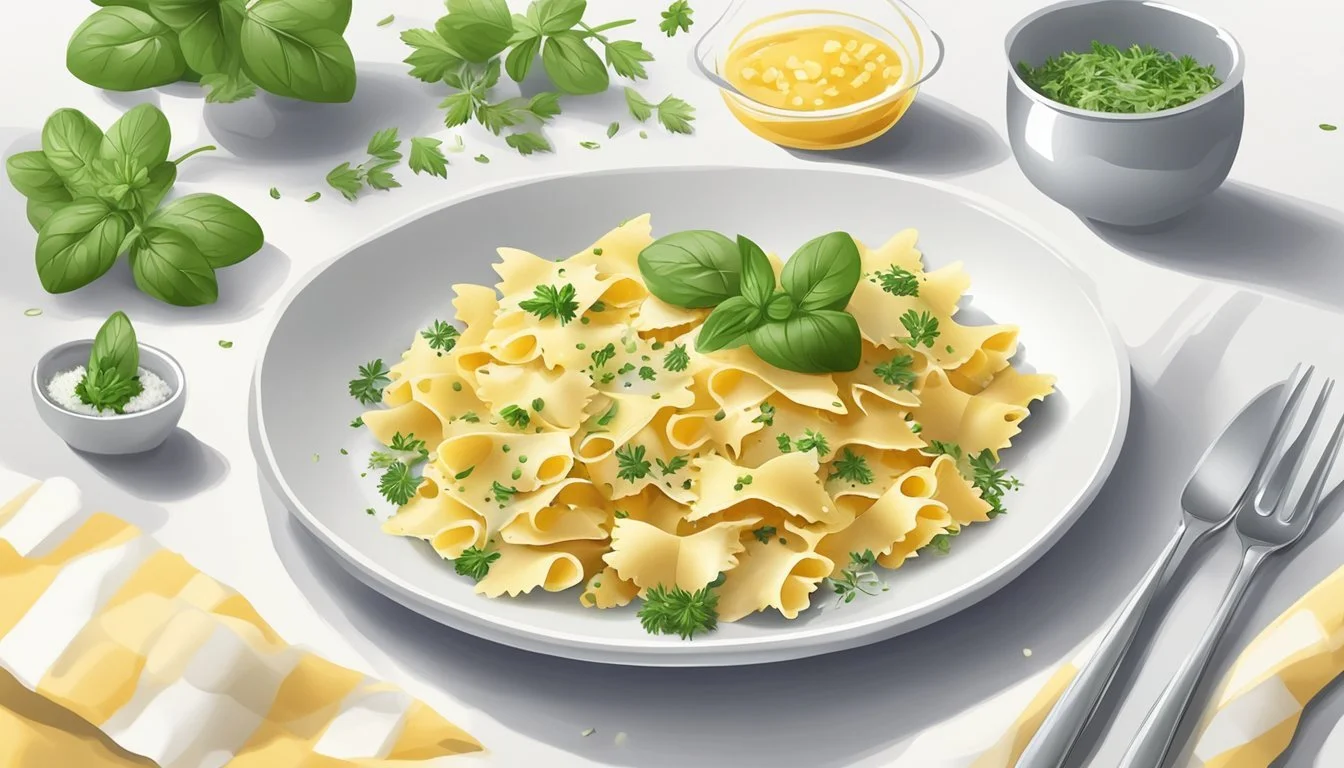How Long Does Farfalle Pasta Last?
Shelf Life and Storage Tips
Farfalle pasta , commonly known as bow tie pasta (What wine goes well with pasta?) due to its distinctive shape, is a versatile staple in many pantries. Its durability is one of its many conveniences, allowing it to be stored for future use. Dry farfalle has an impressive shelf life, retaining its quality for up to three years when stored properly at room temperature. This longevity is due to the low moisture content of dry pasta, which inhibits the growth of microorganisms that lead to spoilage.
To ensure that farfalle pasta maintains its best quality over time, it should be kept in a cool, dry place away from heat and light. The original packaging is often sufficient to protect the pasta for a while; however, once opened, transferring the pasta to an airtight container can help to extend its shelf life by preventing exposure to air and humidity. It is important to note that while dry farfalle pasta may remain safe to consume after the three-year mark, its texture and flavor could start to diminish.
When it comes to cooked farfalle, the timeline for consumption is much shorter. Refrigeration is crucial, and properly stored cooked farfalle is best enjoyed within five days. Ensuring that the pasta is cooled to room temperature before sealing it in an airtight container and placing it in the fridge can keep it from becoming overly soggy or developing harmful bacteria. Thus, understanding how to store farfalle properly—both dry and cooked—is key to enjoying its quality and taste over time.
Known Varieties of Farfalle Pasta
Farfalle pasta is recognized by its distinctive shape that resembles butterflies and bow ties. This pasta is frequently made from semolina or all-purpose flour, with semolina flour (how long does semolina flour last?) offering a firmer texture that holds up well to various sauces.
Bow Tie Pasta
Bow tie pasta is another name for farfalle because its shape mimics the elegant silhouette of a bow tie. It's a versatile pasta used in a plethora of dishes from pasta salads to hot entrees. Typically made from semolina flour or an alternative all-purpose flour, bow tie pasta provides a delightful al dente texture when cooked properly.
Butterfly Pasta
Butterfly pasta is what farfalle is referred to in some culinary contexts because of its shape that resembles a butterfly with outstretched wings. The pleated middle helps to catch sauces, enhancing the flavor profile of dishes. Butterfly pasta, just like bow tie pasta, is made using semolina or all-purpose flour, contributing to its robustness in various recipes.
Cooking Instructions for Farfalle
The proper technique for cooking farfalle pasta involves a balance of adequately salted, boiling water and precise timing to achieve the desired al dente texture. Attentiveness is key throughout the boiling process to ensure even cooking.
Prep Time and Cook Time
Prep Time: Typically negligible, as it usually involves only ensuring adequate water and salt are on hand.
Cook Time: Ranges from 10 to 12 minutes depending on the specific brand of pasta and desired texture.
Boiling Water and Stirring
One should begin by filling a large pot with water, allowing for enough space for the pasta to move freely. It is critical to bring the water to a boiling point before adding the pasta. The addition of salt, about 1-2% in proportion to the water, is essential as it seasons the pasta and elevates its flavor. Stirring the pasta occasionally prevents it from sticking and promotes even cooking.
Reaching Al Dente Texture
Farfalle pasta is known for its distinct bow tie shape, which requires a careful approach to achieve an al dente texture. This involves cooking the pasta until it is still firm to the bite. It's vital to frequently test the pasta as it nears the end of the cooking time to prevent it from becoming overcooked. Once the desired texture is reached, the pasta should be promptly drained to halt the cooking process.
Best Practices for Storing Farfalle Pasta
Proper storage is crucial for maintaining the quality and extending the shelf life of farfalle pasta, whether it's dry or cooked. Ensuring dry pasta is kept in optimal conditions and cooked pasta is refrigerated appropriately will allow consumers to enjoy the pasta at its best quality for as long as possible.
Dry Pasta Storage
Dry farfalle pasta, also known as bow tie pasta, should be stored in a cool, dry place away from moisture and heat. To maximize the shelf life of uncooked farfalle pasta, which can last up to two to three years under ideal conditions, adherence to the following guidelines is recommended:
Packaging: Keep the pasta in its original packaging, if it's strong and intact. Otherwise, transfer the pasta to an airtight container or a sealable plastic bag.
Environment: Store the container in a cool, dark cabinet or pantry, away from any sources of heat like stoves or heating vents which can accelerate degradation.
Moisture: Ensure that the storage area is free from moisture, as this can lead to mold growth.
Cooked Farfalle Storage
After cooking, farfalle pasta should be stored properly to maintain taste and texture. To retain the quality of cooked farfalle pasta, one should consider the following practices:
Cooling: Allow the pasta to cool to room temperature before storing to prevent condensation, which can contribute to sogginess and bacterial growth.
Refrigerating: Place the cooled pasta in an airtight container before putting it in the fridge to maintain freshness. Cooked pasta should be consumed within 2-5 days.
Containers: Use glass or plastic containers with tight-sealing lids to protect the pasta from absorbing other flavors and odors in the fridge.
By following these storage principles, consumers can ensure their farfalle pasta remains fresh and delicious until its next use.
Safety Considerations When Storing Pasta
When it comes to storing pasta like farfalle, safety is paramount. Understanding the proper storage duration and recognizing signs of spoilage are crucial steps to prevent foodborne illnesses and to ensure the pasta remains safe to consume.
Safe Storage Duration
Safe storage duration for dry farfalle pasta is typically around 3 years when kept at room temperature in a well-sealed container. For optimal preservation, it should be stored in a dry, cool area away from direct light, heat, and moisture. Here is a quick reference:
Storage Condition Expected Safe Duration Room temperature Up to 3 years Airtight container Maintains quality best Free from moisture and heat Prevents spoilage
Signs of Spoilage
Farfalle pasta can show signs of spoilage, and recognizing these is key to food safety:
Mold: Visible spots or mold growth on any part of the pasta.
Odor: Off or rancid smell indicating the pasta may have turned bad.
Texture: A slimy or sticky substance on pasta may suggest bacterial growth.
If the farfalle exhibits any of these signs, it should be discarded immediately to avoid health risks such as food poisoning.
Adding Flavor to Farfalle Pasta
To elevate the taste of farfalle pasta, incorporating the right balance of sauces or simple applications of oil and butter can make a substantial difference in flavor. This section explores specific sauce pairings and oil and butter applications that are ideal for farfalle pasta.
Sauce Pairings
When selecting a sauce for farfalle pasta, consider the sauce's texture and flavor profile in relation to the pasta's shape and surface area.
Pesto Sauce (how long does pesto sauce last?): Its fresh and aromatic qualities cling well to the "wings" of farfalle.
Alfredo Sauce: A creamy and rich choice that provides a velvety coat to each piece.
Bolognese Sauce: A hearty meat-based sauce that nestles into the pasta's crevices, providing a robust flavor with every bite.
Herbs and Spices to Consider:
Basil: A mainstay in pesto that can also be added fresh to any sauce for a burst of flavor.
Oregano: Works well with tomato-based sauces (What wine goes well with tomato-based sauces?) like bolognese.
Garlic: Enhances the depth of any sauce, from alfredo to pesto.
Oil and Butter Applications
The simplicity of oil and butter can bring out the nuanced flavors of farfalle pasta without overpowering it.
Best Practices for Oil:
Extra Virgin Olive Oil: Drizzle for a fruity undertone.
Garlic-infused Oil: Saute briefly to embed a pungent kick.
Best Practices for Butter:
Melted Butter: Coat evenly for a rich mouthfeel.
Browned Butter: Offers a nutty dimension that complements the pasta.
Types of Oil and Butter to Use:
Extra Virgin Olive Oil: Ideal for a light, fresh flavor.
Butter: Unsalted for controlled seasoning, allowing the pasta's flavor to shine.
Making Homemade Farfalle
When making homemade farfalle, often referred to as bowtie pasta, one must pay special attention to preparing the dough and mastering the shaping technique. It is a process that marries simplicity with a touch of artisanal craft.
Creating the Dough
The base of homemade farfalle starts with a simple pasta dough. The dough typically includes all-purpose flour, eggs, and a pinch of salt, adhering to the ratio of 1 cup of flour to 1 large egg. To make the dough:
Place the flour on a clean work surface, forming a mound.
Create a well in the center of the mound.
Crack the eggs into the well and add the salt.
Gradually incorporate the flour into the eggs using a fork, starting from the inside of the well outwards.
Once mixed, knead the dough for about 10 minutes, or until it achieves a smooth and elastic texture. If necessary, adjust with water to reach the desired consistency. Dough that is too dry or too wet will affect the pasta's final quality. After kneading, let the dough rest, covered, for 30 minutes at room temperature to relax the gluten.
Shaping Farfalle Pasta
After the dough has rested, it's time to shape the homemade farfalle. The pasta maker or rolling pin can be employed to roll out the pasta dough evenly:
Divide the dough into manageable sections.
Flatten each section with a pasta maker, gradually reducing the thickness setting, until it reaches about 1 millimeter thick. A rolling pin can alternatively be used to achieve the desired thinness.
With the sheet of dough laid out flat, use a pizza cutter or a knife to trim the edges and cut into small rectangles, approximately 1 inch by 2 inches.
The hallmark of farfalle is its distinctive "pinched" middle. To create this:
Take each cut rectangle and use your fingers to pinch the dough together firmly in the center, forming the characteristic bowtie shape.
The name 'farfalle' comes from the Italian word for butterflies, indicative of the pasta's unique shape. These shapes not only look appealing but also hold onto sauces well, making homemade farfalle a delightful addition to a variety of dishes. Once shaped, the pasta should be allowed to dry slightly before cooking to maintain its structure.
Freezing and Reheating Farfalle
Properly freezing and reheating farfalle pasta is crucial for maintaining its quality and safety. The processes are straightforward but require attention to detail to ensure the pasta retains its texture and taste.
How to Freeze Farfalle
To freeze cooked farfalle pasta effectively, one should:
Cool the pasta completely after cooking it to avoid ice crystallization caused by warm temperatures.
Divide the pasta into portion sizes to simplify the reheating process.
Place the pasta into freezer bags, removing as much air as possible to prevent freezer burn.
Label the bags with the contents and the date to keep track of the total time they have been in the freezer.
It's recommended to consume the frozen farfalle within two months to enjoy the best quality.
Thawing and Reheating Methods
For thawing and reheating cooked farfalle:
Refrigerate: One can thaw the pasta in the refrigerator overnight, which is the safest method to minimize bacterial growth.
Microwave: To reheat, transfer the pasta to a microwave-safe dish, optionally adding a splash of water to prevent drying out. Use the microwave's reheat setting or heat on high for 1-2 minutes, stirring occasionally to heat evenly.
Pasta reheated from frozen state should reach an internal temperature of 74°C (165°F) to ensure safety.
Nutritional Facts and Dietary Considerations
When one is considering incorporating farfalle pasta into their diet, particularly for dinner as a main course in Italian cuisine, it is crucial to pay attention to its caloric content and the presence of gluten and fiber. These factors are paramount when determining the suitability of farfalle pasta for various dietary requirements and meal planning for a given number of servings.
Caloric Content
Farfalle pasta, commonly referred to as bow-tie pasta, typically contains around 200 calories per 1 cup of cooked pasta. The number of calories may vary depending on the brand and the way it is prepared. When it is the main course of a meal, one should account for the calories from the pasta alongside any sauces or accompaniments to ensure they align with their dietary goals.
Gluten and Fiber Information
Farfalle is traditionally made from wheat, which means it contains gluten. Individuals with celiac disease or gluten sensitivity should opt for gluten-free alternatives made from lentil, bean, or pea flour. These gluten-free variants also offer the additional benefit of increased fiber. Regular farfalle pasta provides approximately 2 grams of dietary fiber per serving, contributing to the recommended daily fiber intake. Fiber is essential for digestive health and can be a point of consideration for those looking to enhance their diet.
Lifespan of Various Farfalle Preparations
When considering the lifespan of farfalle pasta, it's crucial to differentiate between uncooked and cooked states, as these have significantly distinct shelf lives, affected by factors like storage conditions and preparation.
Shelf Life of Dry Farfalle
Unopened and Properly Stored: Up to 2 years.
Optimal Conditions: Cool, dry place away from light and heat.
Quality Preservation: Store in a tightly sealed container to maintain best quality.
Dry farfalle pasta, when kept in its original packaging and stored correctly, can maintain its quality for up to two years. The shelf life can extend to about three years, but for optimal freshness and to prevent the pasta from becoming mushy when cooked, it's advised to use it within the two-year mark. The key to prolonging its shelf life is to ensure it's in an environment that is void of moisture and extreme temperature changes.
Freshness of Cooked Farfalle
Refrigeration: Store in an airtight container.
Shelf Life: 3-5 days in the refrigerator.
Once farfalle pasta is cooked, its freshness diminishes at a faster rate. Refrigeration is essential, and one should consume the cooked pasta within three to five days to enjoy its best quality. Beyond this period, the pasta may lose its texture and may become unpalatable. Ensuring that cooked farfalle is stored in an airtight container is crucial to prevent it from absorbing odors and tastes from other foods.
Pasta Dish Presentation and Serving Tips
When it comes to presenting and serving farfalle or butterfly pasta, achieving the perfect texture and appearance is crucial. Attentiveness during cooking and an eye for detail can elevate a simple pasta dish to a culinary delight.
Avoiding Common Cooking Mistakes
Proper Cooking Technique: Farfalle should be cooked in a large pot of salted boiling water for about 10 to 12 minutes, but the precise timing should be checked against the package instructions. Overcooking can lead to a mushy texture, while undercooking leaves an unpleasant bite.
To Prevent Sticking: Stir the pasta occasionally while it cooks and use a sufficient amount of water. After draining in a colander, one can toss the farfalle with a little bit of oil or sauce to keep individual pieces from sticking together without affecting the texture.
Enhancing the Appearance of Dishes
Plating: First impressions matter, and eating with the eyes precedes any tactile or taste experience. Use the butterfly shape of the farfalle to create an appealing presentation on the plate, contrasting the pasta with colorful sauces or garnishes.
Garnishes and Accompaniments: Fresh herbs, grated cheese, or a light drizzle of high-quality olive oil can add both flavor and visual appeal. Consider adding complementary colors and textures to make the dish visually striking and to enhance the overall experience.
Additional Tips for Perfect Farfalle
Achieving perfection with farfalle, also known by its Italian word for "butterflies," involves attention to detail and a few specialized tools. Below are key strategies to ensure that each bow-tie shaped pasta comes out impeccably balanced and al dente.
Preferred Cooking Tools
To cook farfalle pasta to perfection, chefs recommend the use of specific tools. A large pot ensures there is ample room for the pasta to move freely and cook evenly. Using a wooden spoon is essential for stirring the farfalle within the first minute of cooking to prevent sticking. After this, it is critical not to over-stir, as farfalle is prone to losing its shape with excessive handling. When draining the pasta, a colander with small holes will keep the delicate farfalle intact. For homemade farfalle, a sharp knife is a must-have for cutting even-sized pieces, and a ravioli wheel cutter can be used to crimp the edges for an authentic look.
Creating Balanced Farfalle Dishes
The shape of farfalle is ideal for capturing thick and creamy sauces within its folds. To create a balanced dish, pair farfalle with ingredients that complement its texture and form. Thinner sauces may slip off, so opt for heartier ones like Alfredo or a robust meat sauce. Salad dishes gain dimension with farfalle's shape, which allows it to mix harmoniously with a variety of vegetables. When sauce is part of the recipe, ensure that the farfalle is coated evenly for a consistent flavor in every bite. Offering a harmony of flavors and textures, farfalle stands as a versatile pasta that shines across diverse pasta dishes when prepared with these considerations in mind.

